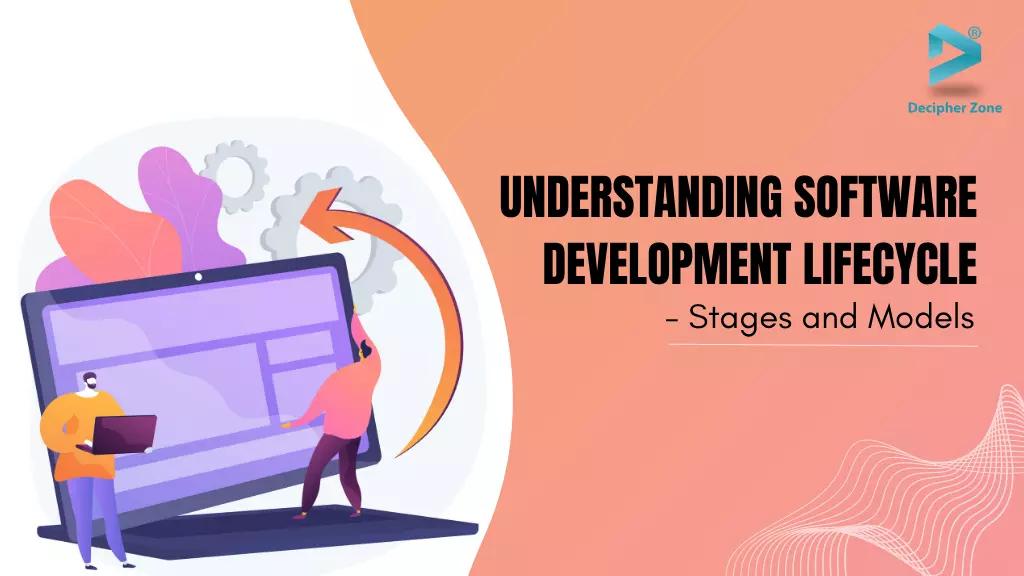Understanding Software Development Lifecycle - Phages and Models. The software has played an essential role in business growth. It has helped businesses gain a competitive edge in the marketplace, generating more revenue and boosting their profits.
Be it a large-scale business like Amazon or any medium-scale or small-scale business, software development has catered to them all.
Software Development Lifecycle - Guide to Stages and Models
However, it is also important that you follow all the necessary steps to develop a top-notch software solution that meets all your business needs and fulfills your customer demands.
And one such process is the software development lifecycle.
So, if you are interested in developing an application or software, then this article will surely help you out with your business needs.
What is the Software Development Lifecycle (SDLC)?
Software development life cycle is a process that helps in designing, developing, and deploying high-quality software which aims to satisfy both the business and its customer's requirements.
It also helps in improving the software development process and boosts the productivity of the developers, making it a time-saving and cost-effective process. Furthermore, the Software Development Life Cycle (SDLC) Phases & Models.
6 Stages of the Software Development Lifecycle (SDLC)
The software development life cycle has six primary stages, and they are -
Stage 1: Requirement Analysis and Planning
Stage 2: Defining Requirements
Stage 3: Design
Stage 4: Coding
Stage 5: Testing
Stage 6: Deployment
Stage 1. Requirement Analysis and Planning
It is the first and foremost step of the SDLC, where the client requirement is gathered alongside collecting and analyzing the information from the target audience, surveys, and researching the industry leaders.
It helps you build a basic outline of the project and plan accordingly to decide the objectives and outcomes and eliminate the risks. It also helps in identifying all the possible approaches, techniques, and models you can consider to develop a full-fledged future-proof software.
Stage 2. Defining Requirements
Once the planning and requirements analysis is done, the next step is to define the requirements.
In this step, the requirements are documented in an SRS (Software Requirement Specification) document, which consists of every detail about the software including the features, functionality, technology stack, goals, cost, and everything else that is needed during the software development process.
Stage 3. Design
How to bring the documented requirements to life? The answer is a Design Plan.
In this step, a design document specification or a DDS is prepared, which usually consists of one or more design approaches or solutions based on different parameters like project robustness, risks, budget, time, and several other aspects that are needed to develop a scalable, reliable, and high-end software.
Next, the design approach is selected, which includes feedback and suggestions from the client and the stakeholders for a better workflow of the project alongside the project schedule, integrations, tools, and technology choices.

Stage 4. Coding
After planning, analysis, defining requirements, and design, coding is the most important part of the software development lifecycle. In this step, the actual development of the project is initiated.
Here the developers choose a programming language, and other important elements to work in a detailed and organized manner and implement all the features and functionalities to get the desired result.
Furthermore, in this step, the developers follow strict coding guidelines to make sure that the development process is hassle-free and seamless by using different development tools like debugger, compiler, and interpreters.
Stage 5. Testing
Another important step of the software development life cycle is testing. In this step, the final product that is developed is tested by the QA engineers and the testers to find the errors, bugs, and defects in the end product using different levels of testing and debugging techniques.
Next, the errors are located and fixed and then tested again to ensure that the software is performing as defined in the SRS document.
Stage 6. Deployment
Once the software is error-free and works perfectly as determined in the initial stage of the software development lifecycle, the last step is deployment.
In this stage, the software is deployed on the respective server and is made available to be used by the business and the end-users, followed by maintenance and support as needed and discussed in the SRS document.
Now that you are familiar with the phases involved in SDLC it is also important that you should know about the various models of SDLC as well.
6 Models of SDLC (Software Development Lifecycle)
There are six different models of the software development lifecycle, and they are as follows -
-
Big Bang Model
-
Iterative Model
-
Spiral Model
-
V-Shaped Model
-
Waterfall Model
1. Agile Model
It combines the iterative and incremental process and focuses on rapid delivery along with customer satisfaction. In this model, the products are divided into iterations and last for about two to three weeks.
The different areas in this model include planning, requirement analysis, design, coding, unit testing, and acceptance testing.
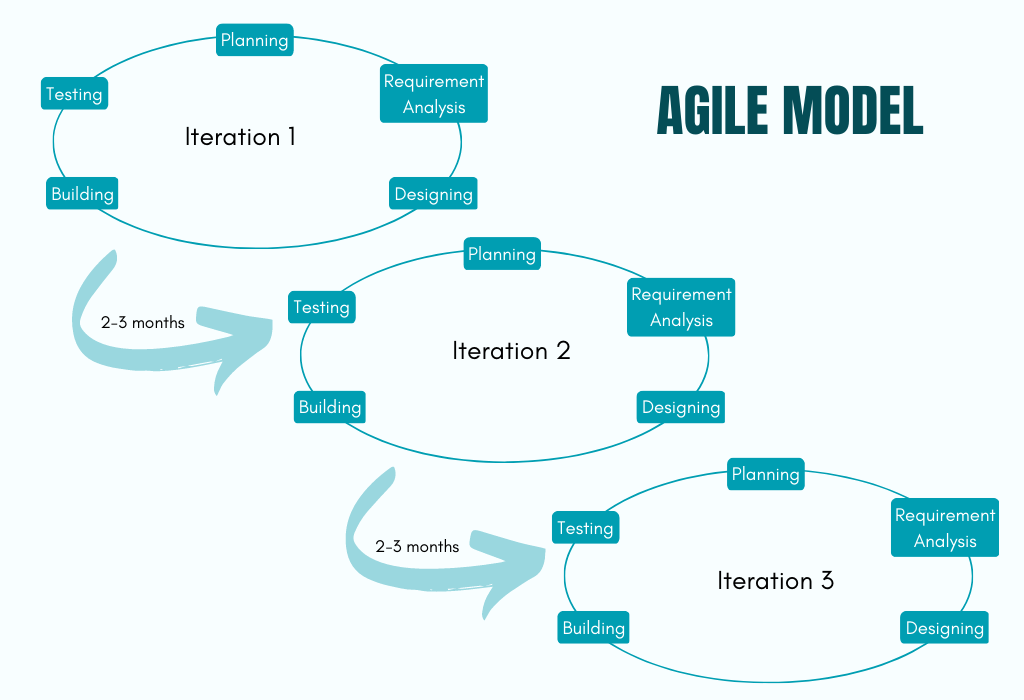
The pros of using the agile model are as follows -
-
It provides a realistic approach to developing software and also enables flexibility and adaptability.
-
It requires minimum resources and suits best for the changing requirements.
-
In addition, it has minimum rules and it requires little or no planning to develop an application.
-
It is easy to manage and also enables early delivery.
2. Big Bang Model
This model does not follow any specific process, all you need is money and a development team to start with the project. This model only requires only little or no planning and the requirements are easily implemented without much analysis.
It helps in developing small projects that require not many developers.
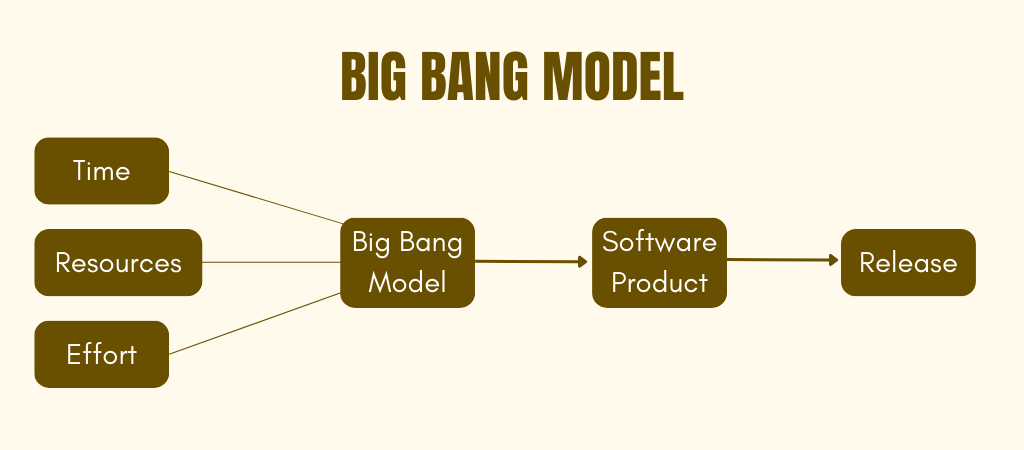
The pros of the big bang model are -
-
It is simple and cost-effective and requires less or no planning to develop software.
-
It is easy to manage and helps in learning for newbies and beginners.
-
It requires minimal resources and requires no formal procedure.
3. Iterative Model
In this model, the process starts with a simple implementation which gradually and iteratively develops and evolves until the entire system is implemented and ready to be launched.
To start development using this model, you do not require a full specification of requirements, instead, you can just implement the parts of the software. This is later reviewed to identify the future requirements of the software and implement them accordingly.
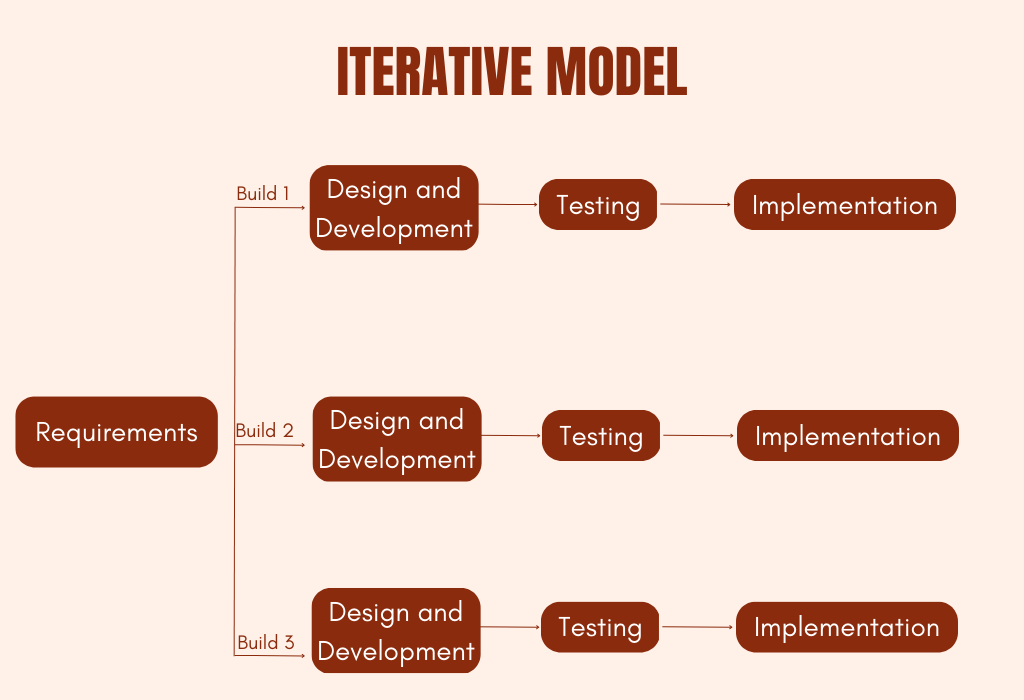
The advantages of using this model are -
-
The primary benefit of this model is that it has a working model of the system at the initial phase which helps in quickly identifying the flaws and errors.
-
Finding the issues at the early stage also helps take corrective measures, which in turn also helps in saving time and money.
-
It helps in planning parallel development and also allows you to measure progress.
-
It also helps in better risk analysis and helps in developing large-scale and complex applications.
-
It also facilitates customer feedback during the lifecycle which helps in improving the quality of the software and providing better end-products to the consumer
4. Spiral Model
This model combines the idea of the iterative model and some aspects of the waterfall model and highly emphasizes risk analysis. It enables incremental development of the product through each phase of the spiral.
It has four phases namely identification, design, construct or build, and evaluation and risk analysis, and the process iteration continues throughout the life of the software.

Furthermore, the benefits of the spiral model are as follows -
-
It easily syncs with the natural development process which minimizes the risk for the business as well as the developers.
-
It easily adapts to changing business requirements.
-
It helps in capturing the requirements precisely and also allows you to divide the development into smaller parts.
5. V-Shaped Model
Also known as the verification and validation model, it is an extension of the waterfall model. In this model, the execution of processes sequentially takes place i.e. in a V-shape.
It is based on the association of testing each of the development phases, which implies that every phase is directly tested as soon as it is developed.
The different verification phases of this model include business requirement analysis, system design, architectural design, and module design.
It also has a coding phase alongside the validation or the testing phase which includes unit testing, integration testing, system, and acceptance testing.
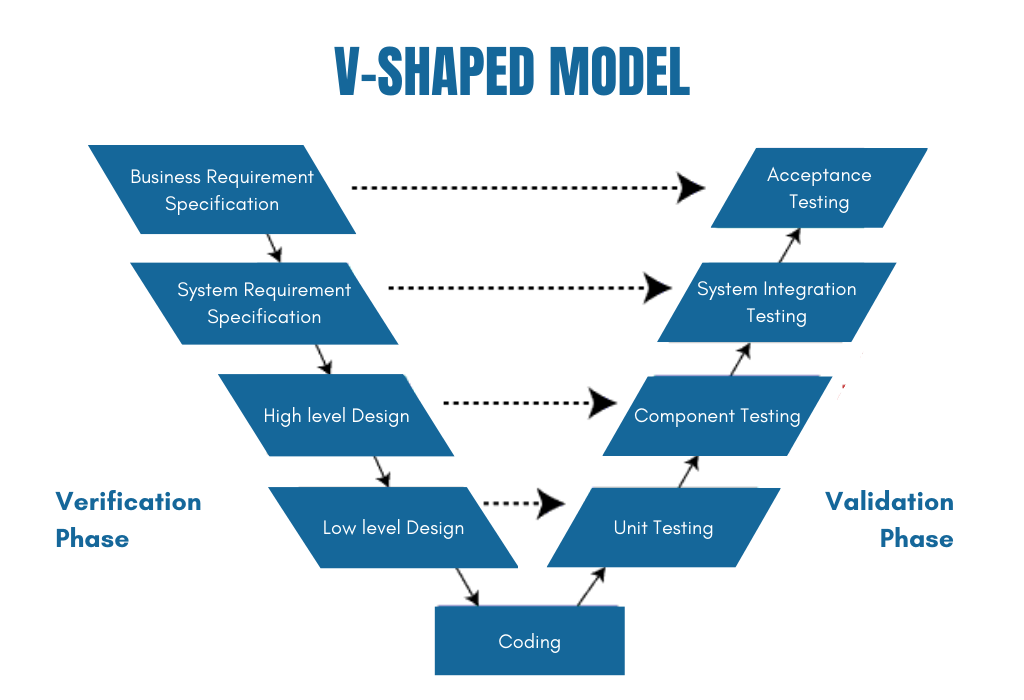
The advantages of the V-shaped model are -
-
It is easy to understand and apply, is simple, and also easy to manage.
-
This model also helps in detecting errors at an early stage.
-
In addition, it also works well with small-scale and mid-scale businesses whose requirements are specified and understood precisely.
6. Waterfall Model
It is also known as the linear-sequential life cycle model and was the very first model to be introduced. This process is simple and there is no overlapping of the development phases.
This means that any new phase of the development model can only begin when the previous phase is complete.
In addition, every phase also has a mini-plan, whose outcomes fall into the next phase sequentially.
The stages of the waterfall development model are requirement gathering and analysis, design, implementation, integration and testing, deployment, and maintenance.
Furthermore, it also helps in scheduling deadlines for each stage of the development phase and also enables departmentalization and control.

Its other advantages include -
-
It is easy to use and arrange tasks.
-
It has clearly defined stages and the process and results are documented well.
-
It works well for businesses whose requirements are precise.
-
It is also easy to manage since every phase has its deliverables and review process.
Summing It Up
Software development is a complex task that continuously evolves according to business requirements, market trends, and consumer demands.
So, if you are thinking of developing software for your business then make sure that you follow the software development life cycle and develop high-quality and high-performing applications.
Connect with us and get the best solutions for your business.
FAQs About Software Development Lifecycle (SDLC)
What are the benefits of the software development lifecycle?
The benefits of the SDLC are -
-
It makes the development process manageable and effective.
-
It helps in transparent communication between the developers and the business owners.
-
It helps in avoiding issues while developing software.
-
It streamlines the development process and makes it easy, and
-
It also helps in saving a lot of time, effort, and money.
What are some of the best software development frameworks?
Some of the best software development frameworks that you can consider learning or for developing top-notch software include Bootstrap, AngularJS, ReactJS, Django, NodeJS, VueJS, and several others.
What are some of the tools that are highly used by developers?
The widely used tools used by developers are compilers, code editors, assemblers, linkers, debuggers, performance tools, and many others.

